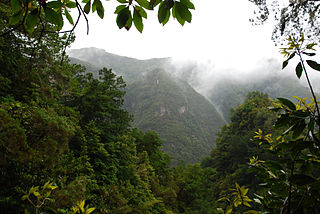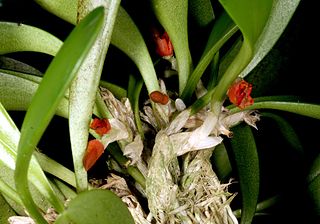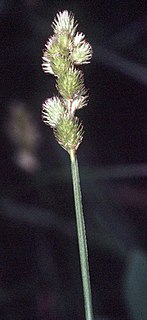
Fagaceae is a family of flowering plants that includes beeches, chestnuts and oaks, and comprises eight genera with about 927 species. Fagaceae in temperate regions are mostly deciduous, whereas in the tropics, many species occur as evergreen trees and shrubs. They are characterized by alternate simple leaves with pinnate venation, unisexual flowers in the form of catkins, and fruit in the form of cup-like (cupule) nuts. Their leaves are often lobed and both petioles and stipules are generally present. Their fruits lack endosperm and lie in a scaly or spiny husk that may or may not enclose the entire nut, which may consist of one to seven seeds. In the oaks, genus Quercus, the fruit is a non-valved nut called an acorn. The husk of the acorn in most oaks only forms a cup in which the nut sits. Other members of the family have fully enclosed nuts. Fagaceae is one of the most ecologically important woody plant families in the Northern Hemisphere, as oaks form the backbone of temperate forest in North America, Europe, and Asia, and are one of the most significant sources of wildlife fodder.

Laurel forest, also called laurisilva or laurissilva, is a type of subtropical forest found in areas with high humidity and relatively stable, mild temperatures. The forest is characterized by broadleaf tree species with evergreen, glossy and elongated leaves, known as "laurophyll" or "lauroid". Plants from the laurel family (Lauraceae) may or may not be present, depending on the location.

Castanopsis, commonly called chinquapin or chinkapin, is a genus of evergreen trees belonging to the beech family, Fagaceae. The genus contains about 140 species, which are today restricted to tropical and subtropical eastern Asia. A total of 58 species are native to China, with 30 endemic; the other species occur further south, through Indochina to Indonesia and the Philippines, mountainous areas of Taiwan, and also in Japan. The English name chinkapin is shared with other related plants, including the golden chinkapins of the Pacific United States, which are sometimes included within Castanopsis but are more often considered a separate but very closely related genus, Chrysolepis.

Castanopsis cuspidata is a species of Castanopsis native to southern Japan and southern Korea.

Mizoram University is a central university under the University Grants Commission, Government of India, and was established on 2 July 2001, by the Mizoram University Act (2000) of the Parliament of India. The President of India is the official Visitor, and the Governor of Mizoram acts as the Chief Rector as per Mizoram University (Amendment) Bill, 2007.

Kaeng Krachan National Park is the largest national park of Thailand. It is on the border with Burma, contiguous with the Tanintharyi Nature Reserve. It is a popular park owing to its proximity to the tourist town of Hua Hin. It was named a UNESCO World Heritage Site on 26 July 2021, despite concerns from the OHCHR around the human rights violations of the indigenous people that live in the park.

Castanopsis concinna is a species of plant in the family Fagaceae. It is a tree found in broad-leaved evergreen forests of southern Guangdong and Guangxi in China and in Hong Kong. It is under second-class national protection in China. It is threatened by habitat loss.
Phakphok is a town and Village Development Committee (VDC) in Ilam District in the Province No. 1 of eastern Nepal. At the time of the 1991 Nepal census it had a population of 4,233 persons living in 734 individual households.

Mitrastemon is a genus of two widely disjunct species of parasitic plants. It is the only genus within the family Mitrastemonaceae. Mitrastemon species are root endoparasites, which grow on Fagaceae. It is also a non-photosynthetic plant that parasitizes other plants such as Castanopsis sieboldii. The parasitic plant was first discovered by botanist Eizi Matuda during an expedition to Mt. Ovand in the state of Chiapas, Mexico. The different species were originally named by a friend of Matuda, Yamamoto in 1925–1926. Mitrastemon yamamotoi is a protandrous plant. Its flowers go through a male phase before transforming into their final female form. The flowers of M. yamamotoi attract a variety of insects ranging from wasps to flies and beetles. Among these, beetles are the best pollinators for this plant since their visit to the flower would pick up a large amount of pollen and they would pollinate from each of the flowers that they had already visited.The plant is endemic to tropical and subtropical forest regions such as Southeast Asia and Japan.
Acrocercops melanoplecta is a moth of the family Gracillariidae. It is known from Hong Kong, India (Meghalaya), Japan, Nepal and Taiwan.
Acrocercops mantica is a moth of the family Gracillariidae. It is known from China (Guangdong), Hong Kong, India (Meghalaya), Indonesia (Java), Japan, Korea and Nepal.
The Flora of Taiwan is the flora of the country of Taiwan, also known as the Republic of China.

Eucidaris is a genus of cidaroid sea urchins known as slate pencil urchins. They are characterised by a moderately thick test, a usually monocyclic apical disc, perforate and non-crenulate tubercles and nearly straight ambulacra with horizontal pore pairs. The primary spines are few and widely spaced, stout with blunt flat tips and beaded ornamentation and the secondary spines are short and apressed. They originated in the Miocene and extant members of the genus are found in the tropical Indo-Pacific Ocean, East Pacific, Atlantic Ocean and Caribbean Sea.
Castanopsis costata is a tree in the family Fagaceae. The specific epithet costata is from the Latin meaning "ribbed", referring to the leaf venation.

Castanopsis indica is a tree in the family Fagaceae.

Specklinia tribuloides is a species of orchid plant native to Central America.

Carex tribuloides, the blunt broom sedge, is a species of flowering plant in the genus Carex, native to the eastern United States, eastern Canada, and Veracruz in Mexico, and introduced in Sweden. It is an important food for soras during their spring migration.

Memecylon plebejum is a tree or shrub species in the Melastomataceae family. It grows in tropical Asia from Thailand to Myanmar, Assam (India) and Bangladesh. It favours slopes of hills and mountains, growing up to 1685m elevation, in the understorey of primary forests primarily. It hosts at least one fruit-fly and two parasitoid wasps. The wood is very hard to cut, making it difficult to use as firewood, but some people use it for agricultural tool handles.

The Mehao wildlife sanctuary was declared with an aim to conserve the biodiversity around the Mehao Lake. The sanctuary is gifted with virgin natural lush green forest and lakes. The sancturary harbours some rare varieties of orchids. The altitude of the sanctuary varies from 900 to 3500 meters. The sanctuary covers 281.5 km2 (108.7 sq mi). Its average winter temperature is 12 °C (54 °F) and its average summer temperature is 36 °C (97 °F).













